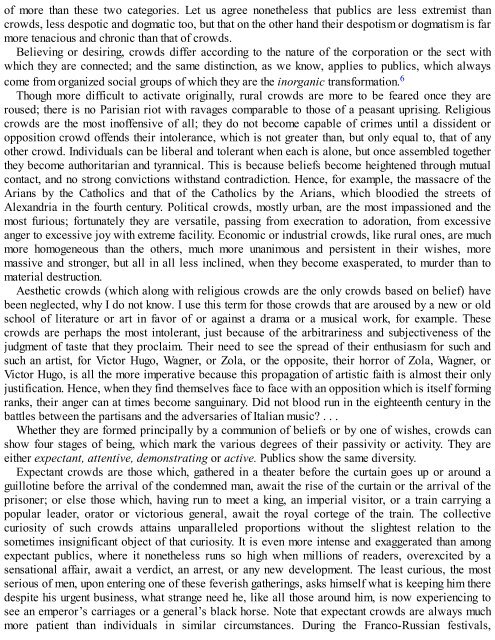3658925934
You also want an ePaper? Increase the reach of your titles
YUMPU automatically turns print PDFs into web optimized ePapers that Google loves.
of more than these two categories. Let us agree nonetheless that publics are less extremist than<br />
crowds, less despotic and dogmatic too, but that on the other hand their despotism or dogmatism is far<br />
more tenacious and chronic than that of crowds.<br />
Believing or desiring, crowds differ according to the nature of the corporation or the sect with<br />
which they are connected; and the same distinction, as we know, applies to publics, which always<br />
come from organized social groups of which they are the inorganic transformation. 6<br />
Though more difficult to activate originally, rural crowds are more to be feared once they are<br />
roused; there is no Parisian riot with ravages comparable to those of a peasant uprising. Religious<br />
crowds are the most inoffensive of all; they do not become capable of crimes until a dissident or<br />
opposition crowd offends their intolerance, which is not greater than, but only equal to, that of any<br />
other crowd. Individuals can be liberal and tolerant when each is alone, but once assembled together<br />
they become authoritarian and tyrannical. This is because beliefs become heightened through mutual<br />
contact, and no strong convictions withstand contradiction. Hence, for example, the massacre of the<br />
Arians by the Catholics and that of the Catholics by the Arians, which bloodied the streets of<br />
Alexandria in the fourth century. Political crowds, mostly urban, are the most impassioned and the<br />
most furious; fortunately they are versatile, passing from execration to adoration, from excessive<br />
anger to excessive joy with extreme facility. Economic or industrial crowds, like rural ones, are much<br />
more homogeneous than the others, much more unanimous and persistent in their wishes, more<br />
massive and stronger, but all in all less inclined, when they become exasperated, to murder than to<br />
material destruction.<br />
Aesthetic crowds (which along with religious crowds are the only crowds based on belief) have<br />
been neglected, why I do not know. I use this term for those crowds that are aroused by a new or old<br />
school of literature or art in favor of or against a drama or a musical work, for example. These<br />
crowds are perhaps the most intolerant, just because of the arbitrariness and subjectiveness of the<br />
judgment of taste that they proclaim. Their need to see the spread of their enthusiasm for such and<br />
such an artist, for Victor Hugo, Wagner, or Zola, or the opposite, their horror of Zola, Wagner, or<br />
Victor Hugo, is all the more imperative because this propagation of artistic faith is almost their only<br />
justification. Hence, when they find themselves face to face with an opposition which is itself forming<br />
ranks, their anger can at times become sanguinary. Did not blood run in the eighteenth century in the<br />
battles between the partisans and the adversaries of Italian music? . . .<br />
Whether they are formed principally by a communion of beliefs or by one of wishes, crowds can<br />
show four stages of being, which mark the various degrees of their passivity or activity. They are<br />
either expectant, attentive, demonstrating or active. Publics show the same diversity.<br />
Expectant crowds are those which, gathered in a theater before the curtain goes up or around a<br />
guillotine before the arrival of the condemned man, await the rise of the curtain or the arrival of the<br />
prisoner; or else those which, having run to meet a king, an imperial visitor, or a train carrying a<br />
popular leader, orator or victorious general, await the royal cortege of the train. The collective<br />
curiosity of such crowds attains unparalleled proportions without the slightest relation to the<br />
sometimes insignificant object of that curiosity. It is even more intense and exaggerated than among<br />
expectant publics, where it nonetheless runs so high when millions of readers, overexcited by a<br />
sensational affair, await a verdict, an arrest, or any new development. The least curious, the most<br />
serious of men, upon entering one of these feverish gatherings, asks himself what is keeping him there<br />
despite his urgent business, what strange need he, like all those around him, is now experiencing to<br />
see an emperor’s carriages or a general’s black horse. Note that expectant crowds are always much<br />
more patient than individuals in similar circumstances. During the Franco-Russian festivals,









![Genki - An Integrated Course in Elementary Japanese II [Second Edition] (2011), WITH PDF BOOKMARKS!](https://img.yumpu.com/58322134/1/180x260/genki-an-integrated-course-in-elementary-japanese-ii-second-edition-2011-with-pdf-bookmarks.jpg?quality=85)
![Genki - An Integrated Course in Elementary Japanese I [Second Edition] (2011), WITH PDF BOOKMARKS!](https://img.yumpu.com/58322120/1/182x260/genki-an-integrated-course-in-elementary-japanese-i-second-edition-2011-with-pdf-bookmarks.jpg?quality=85)





